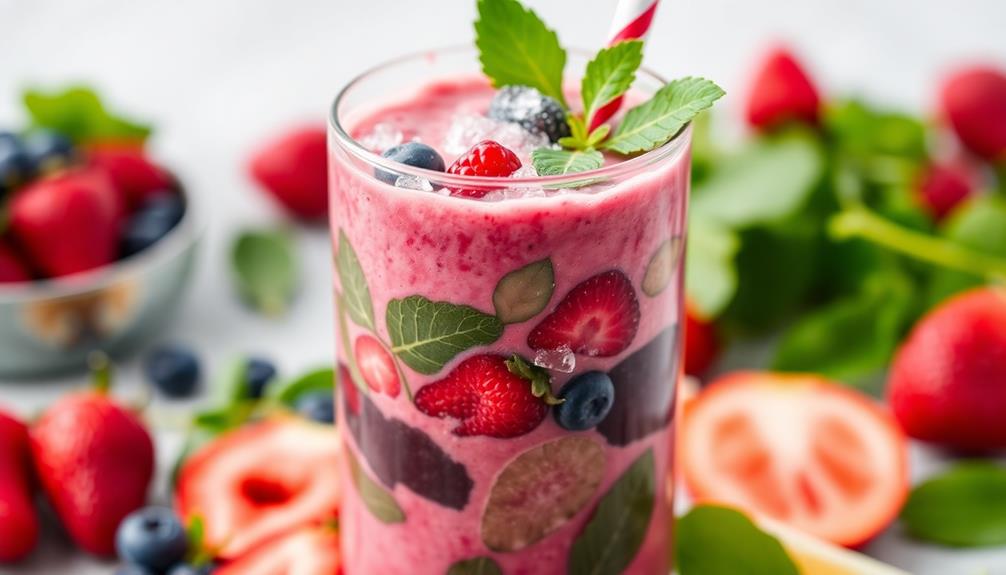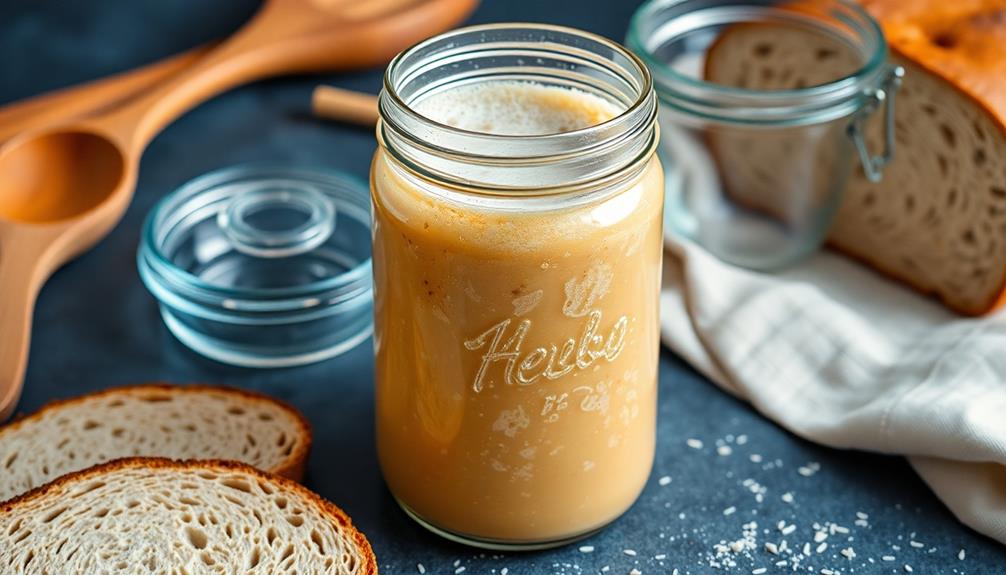Smoothies are a refreshing and nutritious go-to for health-conscious individuals. Packed with essential vitamins, minerals, and antioxidants, they make for a quick morning pick-me-up or afternoon treat. Start by blending together frozen fruit, milk or yogurt, and optional add-ins like chia seeds for a boost of fiber and omega-3s. Blend until smooth and creamy, adjusting the consistency as needed. The possibilities are endless when it comes to flavor combinations – from berry-packed to tropical indulgences. With a little experimentation, you'll be sipping your way to vibrant health in no time. And there's even more to learn about the art of crafting satisfying smoothies.
Key Takeaways
- An easy smoothie recipe incorporates frozen fruits, milk or yogurt, and optional mix-ins like chia seeds for a thick, creamy, and nutritious beverage.
- Blending frozen fruit, such as berries or tropical fruits, creates a naturally sweet and chilled smoothie.
- Incorporating milk or yogurt provides creaminess and additional nutrients like protein and calcium.
- Adding optional ingredients like chia seeds can boost fiber, omega-3s, and overall nutrient density.
- Adjusting the consistency by adding more liquid or ice cubes allows for customization to individual preferences.
History
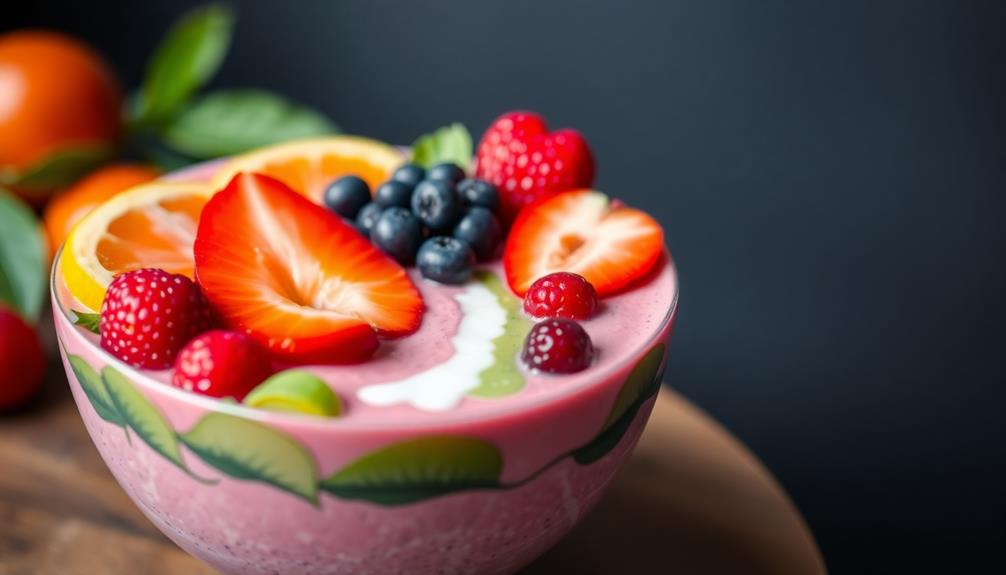
The history of smoothies can be traced back to the 1930s, when health enthusiasts began blending fresh fruits and vegetables into delectable concoctions.
These early smoothie pioneers recognized the nutritional benefits of incorporating whole foods into a drinkable form. Over the decades, the smoothie's popularity has steadily grown, with innovative blends and creative flavor combinations emerging.
Today, smoothies have become a staple in many households, offering a quick and convenient way to pack in essential vitamins, minerals, and antioxidants.
Whether you're looking to start your day with a nutrient-dense breakfast or refuel after a workout, a homemade smoothie can be a delightful and wholesome choice.
As the smoothie trend continues to evolve, it's clear that these versatile beverages have secured their place as a beloved and enduring part of the health-conscious lifestyle.
Recipe

Smoothies are a refreshing and healthy way to start your day or enjoy as a snack. They're versatile and can be customized to suit your taste preferences and nutritional needs. Incorporating ingredients like chia seeds can boost your smoothie with added fiber and omega-3 fatty acids, making it even more beneficial for your health, especially for those following a vegan diet.
Best ways to incorporate omega-rich seeds in your meals can enhance both flavor and nutrition.
In this recipe, we'll be creating a delicious and nutritious smoothie that's perfect for any time of the day. The combination of fresh fruits, vegetables, and other nutrient-rich ingredients will leave you feeling energized and satisfied.
Ingredients:
- 1 cup frozen mixed berries
- 1 banana, peeled
- 1 cup spinach
- 1 cup almond milk
- 2 tablespoons Greek yogurt
- 1 tablespoon honey
- 1 tablespoon chia seeds
Instructions:
In a high-speed blender, combine all the ingredients until smooth and creamy. Blend for 1-2 minutes, or until the mixture reaches your desired consistency. If the smoothie is too thick, add a splash of additional almond milk to thin it out.
Tips:
- Feel free to experiment with different fruit and vegetable combinations to create your own unique smoothie recipes.
- Adjust the sweetness by adding more or less honey, depending on your personal preference.
- For a creamier texture, use Greek yogurt or a dairy-free yogurt alternative.
- Incorporate protein-rich ingredients like nut butters, protein powder, or oats to make the smoothie more filling and nutritious.
Cooking Steps
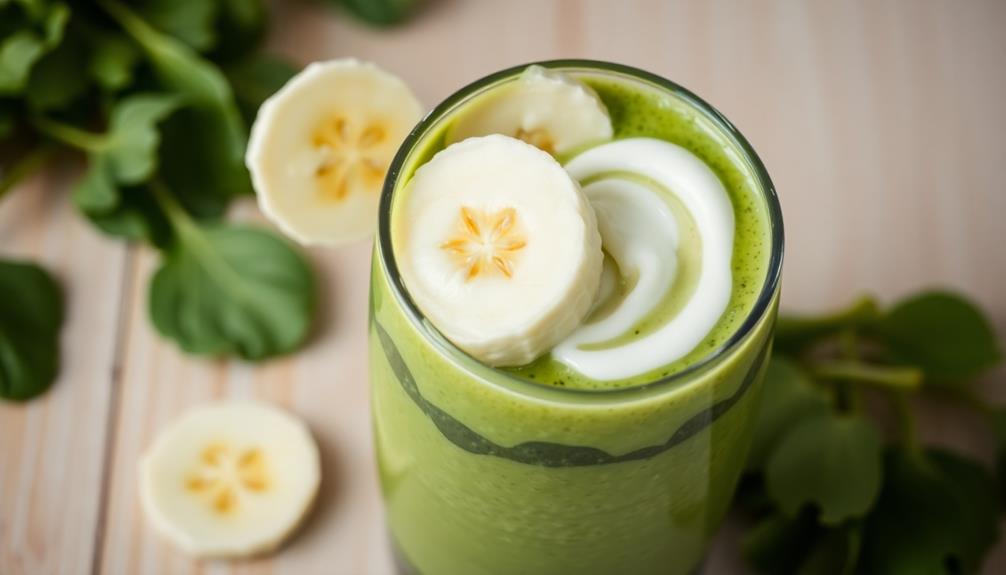
To whip up a delectable smoothie, start by tossing in some frozen fruit.
Next, pour in a splash of milk or yogurt to achieve that creamy texture.
Blend everything together until it reaches a smooth consistency, and feel free to add ice cubes if you'd like an extra-chilled treat.
Step 1. Add Frozen Fruit

Next, add your frozen fruit to the blender. Frozen fruit is a game-changer when it comes to smoothies – it gives your drink a thick, creamy texture and chilled, refreshing flavor.
For best results, use a mix of different frozen fruits, such as:
- Berries (strawberries, blueberries, raspberries)
- Tropical fruits (mango, pineapple, banana)
- Stone fruits (peaches, plums, cherries)
The frozen fruit will provide natural sweetness, so you may need to add less (or no) additional sweeteners. Start with about 1 cup of frozen fruit per serving, and adjust to your taste preferences.
Blend the frozen fruit together with your other smoothie ingredients until smooth and creamy. The frozen component helps create that perfect, frosty smoothie consistency.
Customize your blend with your choice of fresh or frozen fruits for a delicious, nutritious beverage.
Step 2. Add Milk or Yogurt
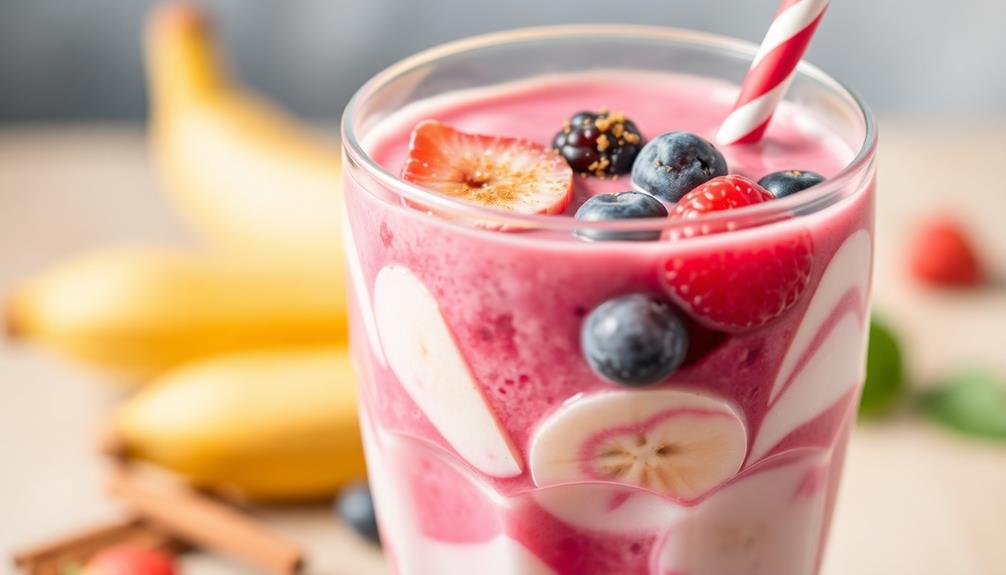
After blending the frozen fruit, it's time to add your choice of milk or yogurt. This creamy addition won't only enhance the texture of your smoothie, but also boost its nutritional profile.
For an extra health kick, consider incorporating chia seeds, which are high in omega-3 fatty acids and fiber, making them a great addition to your smoothie for best health advantages. Milk provides a natural source of protein, calcium, and other essential vitamins and minerals. Yogurt, on the other hand, introduces beneficial probiotics that can support digestive health.
When selecting your milk or yogurt, consider your dietary preferences and any allergies or intolerances. Opt for low-fat or non-fat varieties to keep the calorie count in check. Unsweetened almond, oat, or soy milk make great plant-based alternatives. For yogurt, Greek-style or Icelandic skyr offer a thicker, creamier consistency.
Start by adding a small amount, about 1/2 to 1 cup, and blend until smooth. Adjust the quantity to achieve your desired texture, whether you prefer a thick, creamy smoothie or a thinner, more drinkable consistency.
Don't be afraid to experiment to find your perfect balance of flavors and nutrients.
Step 3. Blend Until Smooth Consistency
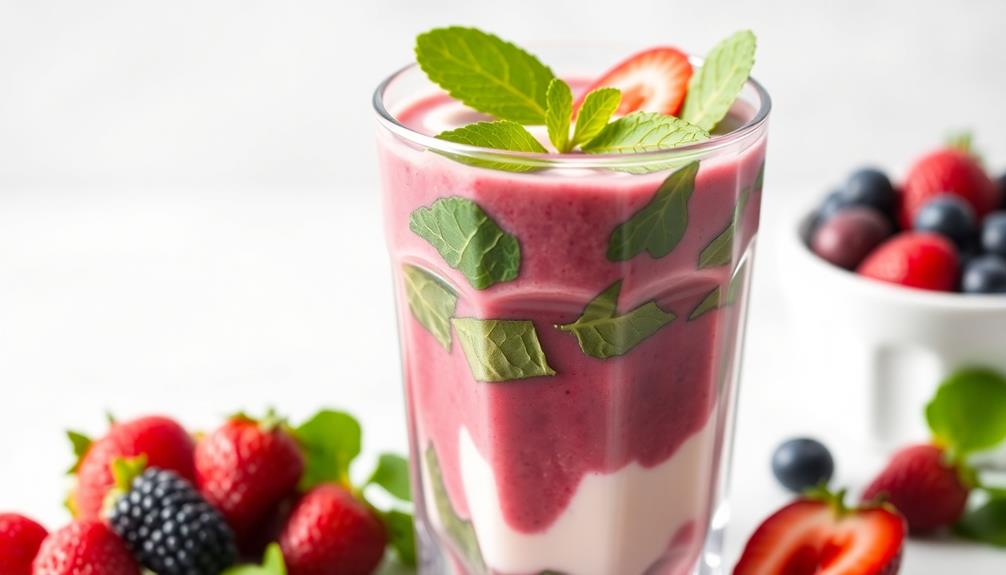
Once you've added your milk or yogurt, it's time to blend everything together until you achieve a smooth, creamy consistency. This blending step is crucial for creating the perfect smoothie texture.
Begin by turning on your blender and letting it run at a high speed. Slowly increase the power as the ingredients start to incorporate. Blend for about 30-60 seconds, or until there are no visible chunks or pieces remaining.
If the mixture appears too thick, you can add a splash of additional milk or yogurt to thin it out. Conversely, if it's too thin, try blending in a handful of ice cubes or frozen fruit to thicken the consistency.
Pay close attention to the texture, stopping the blender periodically to check the smoothness. The goal is a velvety, drinkable smoothie that's free of any gritty or grainy elements.
Once you've achieved the ideal consistency, your smoothie is ready to pour and enjoy!
Step 4. Add Ice if Desired
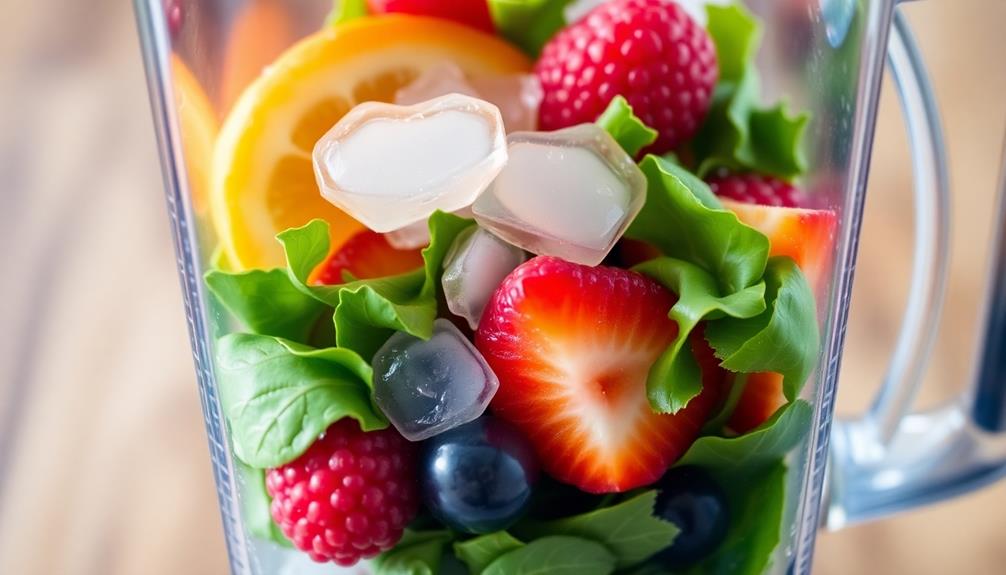
Depending on your personal preference, you can add a handful of ice cubes to your smoothie for a chilled, refreshing texture. This step is entirely optional, as some individuals prefer their smoothies at room temperature or warm.
However, the addition of ice can create a delightful, frosty consistency that's especially welcome on a hot summer day. It’s the perfect way to add a refreshing twist to your favorite drinks, instantly cooling you down. For those looking to elevate their beverage game, consider trying a chilled lemonade recipe for hot days, blending fresh lemons with plenty of ice for that crisp, invigorating sensation. Add a sprig of mint or a touch of honey to customize your perfect thirst-quencher. You can also experiment with different fruit infusions, such as strawberries or raspberries, to enhance the flavor and truly make it your own. A quick search for the *best lemonade recipe for summer* will guide you to exciting variations that are sure to impress. Whether you prefer sweet or tangy, crafting the perfect balance is key to refreshing your taste buds all season long.
When adding ice, be mindful of the amount. Start with just a few cubes and blend until the desired temperature and thickness is achieved. You may need to add more ice if the mixture is too thin or watery.
Conversely, if you prefer a thicker, almost milkshake-like consistency, use less ice.
For a visual reference, the ice cubes should be well-incorporated, with no large chunks remaining. The smoothie should have a uniform, creamy texture throughout.
Feel free to adjust the amount of ice to suit your individual taste preferences and create the perfect chilled refreshment.
Step 5. Serve Chilled and Enjoy
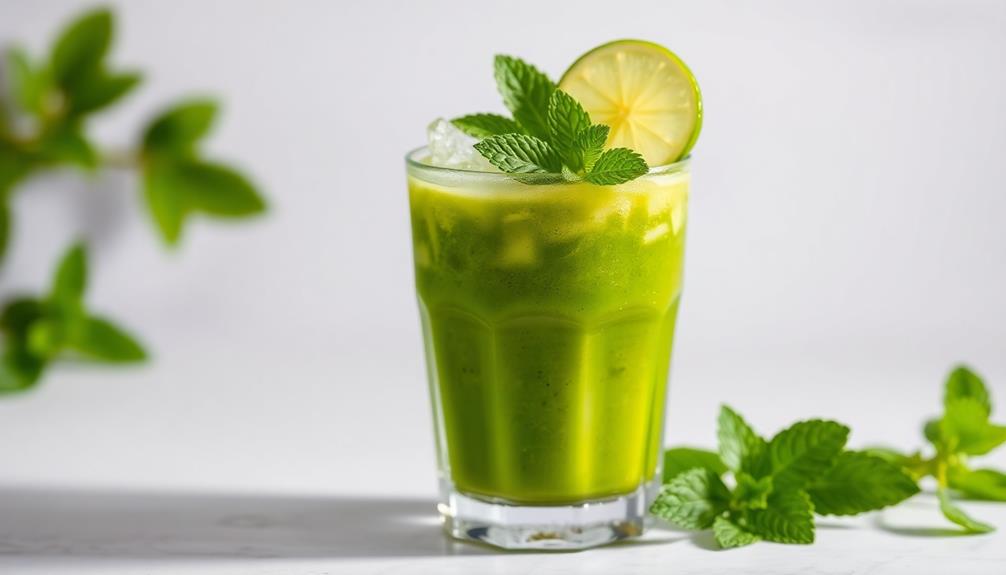
With your smoothie now perfectly chilled and blended, the final step is to pour it into a refreshing glass and savor its vibrant flavors.
The cool, creamy texture and burst of fruity goodness are sure to delight your taste buds. As you raise the glass to your lips, take a moment to appreciate the aromas wafting up, enticing your senses.
When ready, take a sip and let the smooth, refreshing liquid swirl around your mouth. Pay attention to the interplay of flavors – the sweetness, the tartness, the creaminess. Adjust the consistency if needed by adding a splash more milk or yogurt to achieve your desired thickness. Notice how the layers of flavor come together to create a harmonious balance, leaving a pleasant aftertaste that lingers just long enough to invite the next sip. Much like perfecting a classic tartar sauce recipe, achieving the ideal blend requires a bit of experimentation and personal preference. Take this moment to savor your creation, knowing you’ve crafted something uniquely tailored to your taste.
Enjoy your creation in a relaxed setting, perhaps outdoors on a warm day or while curled up with a good book.
Savor every spoonful, taking the time to fully experience the harmonious blend of ingredients you've crafted. As the last drop disappears, smile with satisfaction, knowing you've treated yourself to a delightful and nourishing treat.
Final Thoughts
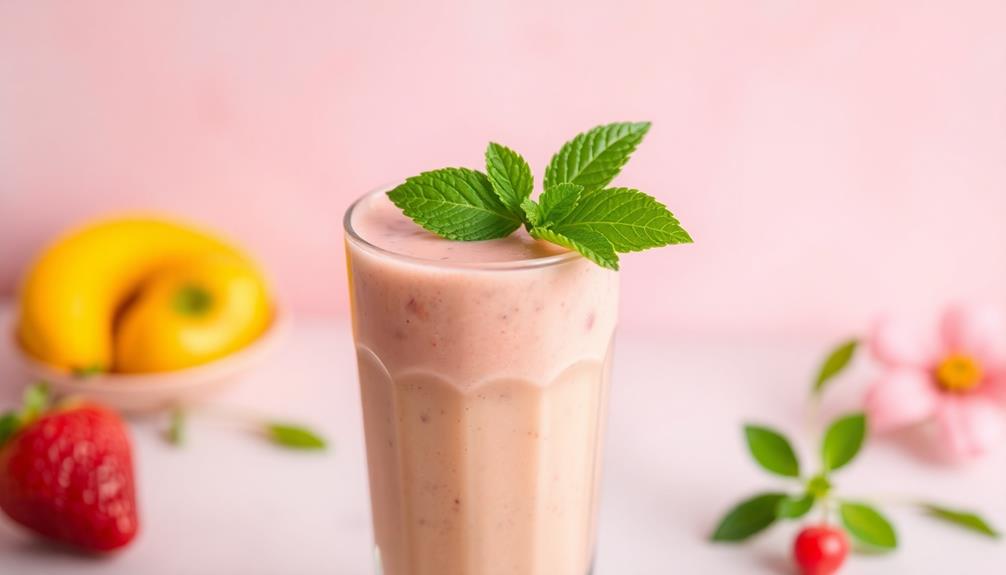
Smoothie-making is an art form, one that requires a delicate balance of ingredients and a keen eye for flavor. As you've discovered, crafting the perfect smoothie is a rewarding journey of experimentation and creativity.
Don't be afraid to play with different flavor combinations, swap in seasonal fruits and veggies, or even try adding a touch of spice for a unique twist. Adding nutrient-dense ingredients like chia seeds' benefits can elevate your smoothie, providing essential minerals and antioxidants that support overall health.
Remember, the beauty of smoothies lies in their versatility. Whether you're looking for a nutritious breakfast, a midday pick-me-up, or a refreshing post-workout treat, a well-made smoothie can be the answer.
Embrace the process, trust your taste buds, and have fun blending your way to smoothie perfection.
As you continue on your smoothie-making adventures, keep these final thoughts in mind: Experiment, improvise, and most importantly, enjoy the ride. Your taste buds and your body will thank you.
Frequently Asked Questions
How Long Does a Smoothie Stay Fresh?
Typically, a homemade smoothie stays fresh for up to 2-3 days when stored properly in the refrigerator. However, it's best to enjoy it within 24 hours for optimal flavor and texture.
Can I Use Frozen Fruits Instead of Fresh?
Yes, you can definitely use frozen fruits instead of fresh. Frozen fruits are just as nutritious and will create a thick, creamy texture in your smoothie. They're also more convenient and last longer than fresh fruits.
What Is the Best Blender for Making Smoothies?
When it comes to making smoothies, you'll want a high-powered blender that can efficiently blend even frozen fruits and vegetables. Look for one with multiple speed settings and a strong motor for the best results.
Can I Add Protein Powder to the Smoothie?
Yes, you can absolutely add protein powder to your smoothie! Protein powder is a great way to boost the nutrition and keep you feeling full and satisfied. Just be sure to adjust the other ingredients to account for the extra powder.
How Can I Make My Smoothie Thicker?
To thicken your smoothie, you can add more frozen fruit, Greek yogurt, nut butter, or even a handful of oats. Blend the ingredients thoroughly to create a creamy, thick consistency that'll satisfy your cravings.
